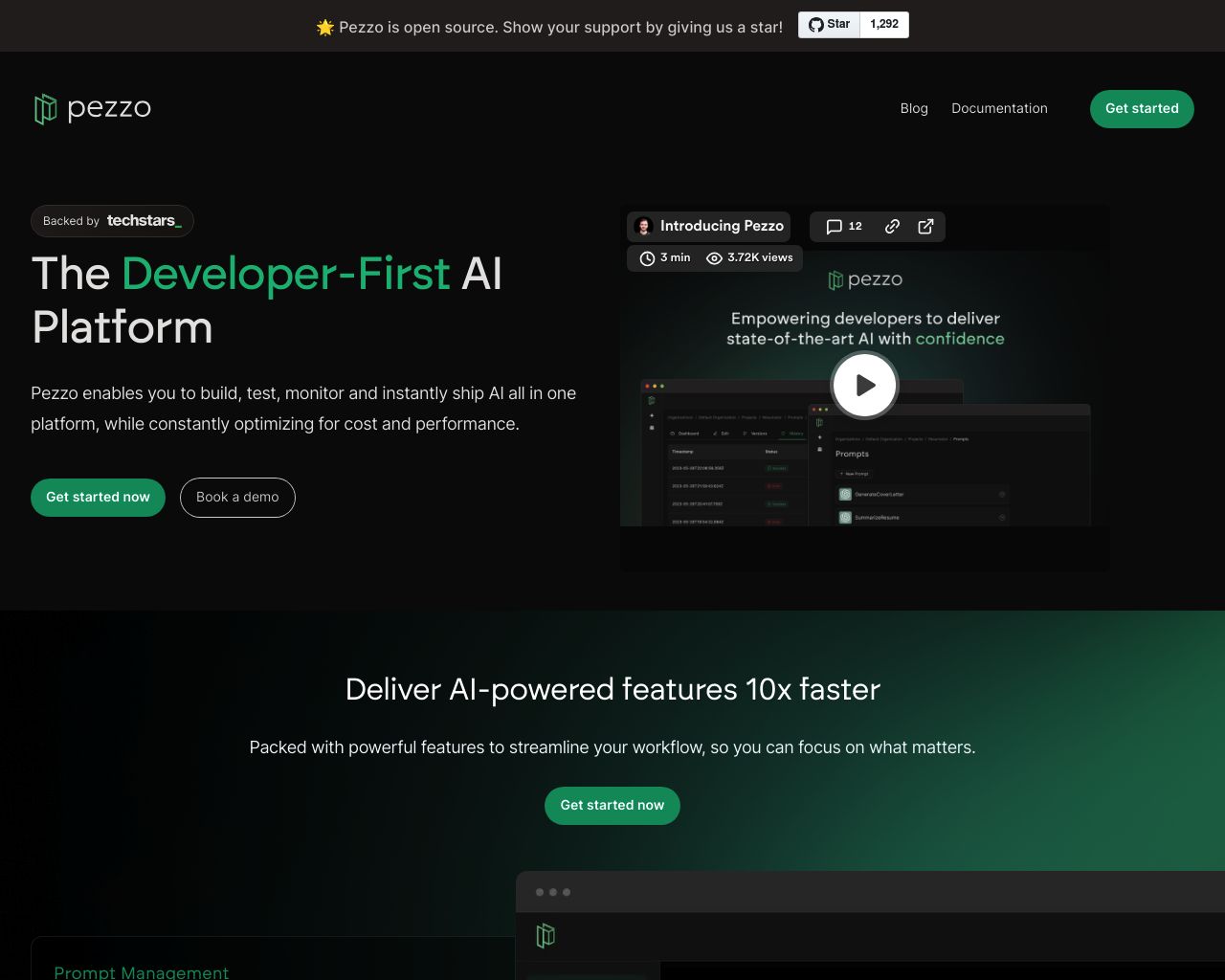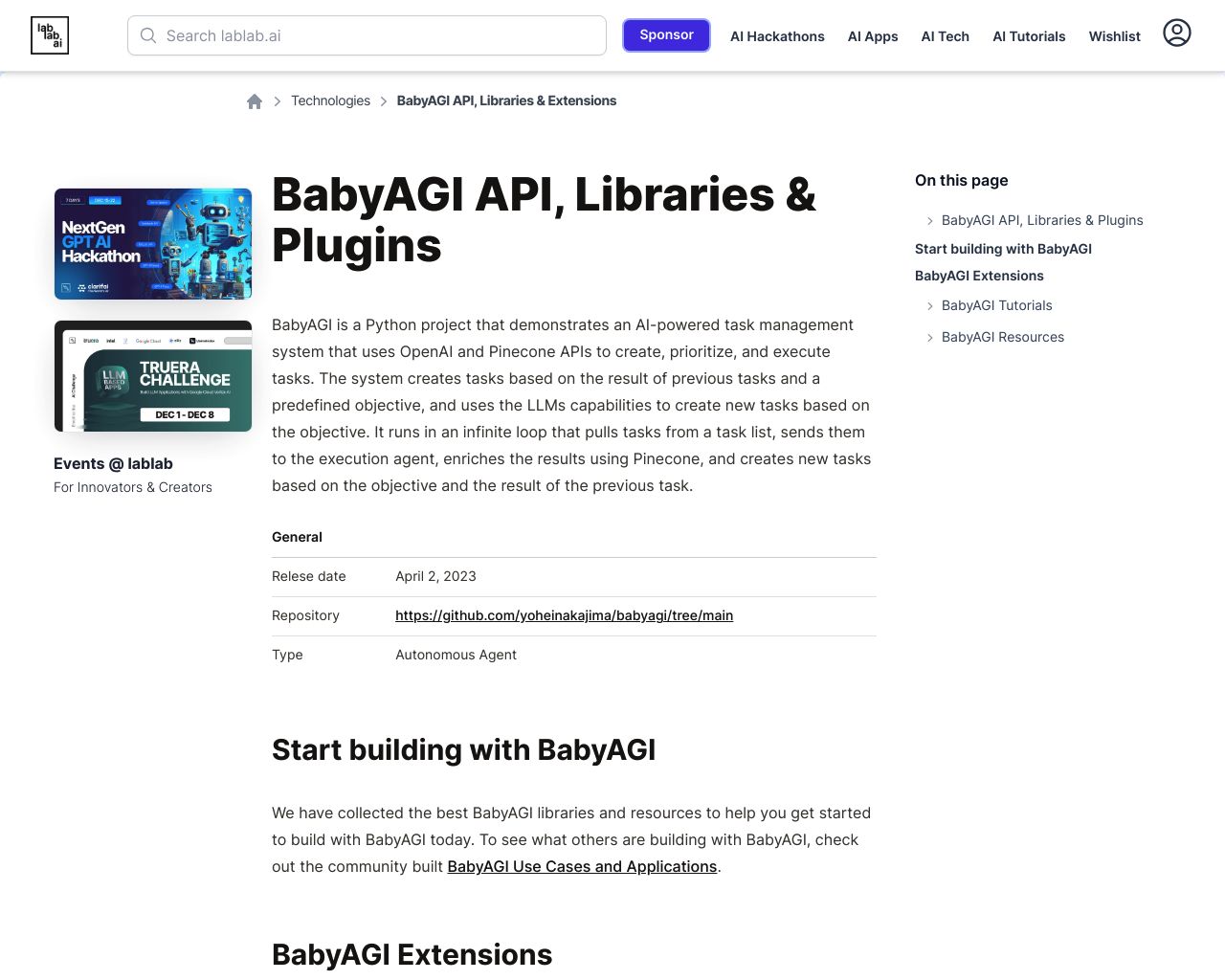A Comprehensive Comparison: Pezzo vs BabyAGI
AI development platforms Pezzo and BabyAGI offer unique approaches to harnessing artificial intelligence, each with distinct strengths and limitations. Pezzo streamlines AI prompt management and optimization, while BabyAGI focuses on autonomous task generation and human-like learning. This comparison explores their key features, use cases, and overall utility, highlighting how SmythOS emerges as a comprehensive solution that combines the best aspects of both platforms while addressing their shortcomings.
Developers, business leaders, and AI enthusiasts will gain insights into how these tools can accelerate AI integration, enhance productivity, and drive innovation across various industries.
Pezzo Overview
Pezzo streamlines AI development with an open-source toolkit designed for efficiency and collaboration. The platform empowers developers to create, manage, and optimize AI prompts seamlessly, accelerating the delivery of AI solutions.


Pezzo’s standout features include effortless prompt and version management, enabling developers to handle multiple AI prompts and versions efficiently. This functionality proves crucial for teams juggling complex AI projects and ensures consistent use of the most up-to-date versions.
Pezzo’s standout features include effortless prompt and version management, enabling developers to handle multiple AI prompts and versions efficiently.
The platform enhances AI performance through A/B testing, targeting, and experimentation tools. These features allow users to optimize their AI models, potentially boosting conversion rates and overall effectiveness. Pezzo also focuses on cost optimization, offering tools that can significantly reduce AI operational expenses—by up to 50% in some cases.
Pezzo distinguishes itself with robust collaboration and transparency features. The platform provides detailed observability into AI operations, reducing debugging time and helping teams pinpoint issues quickly. This level of insight proves invaluable for efficient troubleshooting and smooth operations.
Pezzo distinguishes itself with robust collaboration and transparency features… providing detailed observability into AI operations, reducing debugging time…
While Pezzo excels in many areas, it lacks some advanced features found in other AI development platforms. The absence of a visual builder or no-code editor may limit accessibility for non-technical users. Additionally, Pezzo does not offer specific functionalities for autonomous agents or multi-agent collaboration, which could be limiting for certain complex AI projects.
BabyAGI Overview
BabyAGI pioneers open-source artificial intelligence for autonomous task management. This innovative project simulates human-like cognitive processes, representing a significant step towards artificial general intelligence (AGI).


BabyAGI’s core functionality revolves around autonomous task generation, prioritization, and execution. Unlike traditional AI systems, it creates and manages dynamic task lists based on given objectives. The system continuously learns from previous tasks and adapts to new challenges, mirroring human cognitive processes. It leverages advanced natural language processing capabilities from OpenAI and vector databases like Pinecone to store and retrieve task results efficiently.
BabyAGI’s core functionality revolves around autonomous task generation, prioritization, and execution… it creates and manages dynamic task lists based on given objectives.
The platform stands out for its ability to generate new tasks autonomously based on previous results and predefined objectives. It efficiently prioritizes tasks and integrates memory and learning capabilities, offering a personalized and adaptive approach to task management. This unique combination of features allows BabyAGI to perform complex problem-solving activities across various fields, from customer service and healthcare to education and creative writing.
However, BabyAGI has limitations. It lacks a visual builder or no-code editor, which may present challenges for users without coding experience. The platform also doesn’t offer hosted agents or multi-agent collaboration features, potentially limiting its applicability in certain enterprise scenarios. Additionally, the absence of specific security features like data encryption or OAuth support might concern users dealing with sensitive information.
Despite these drawbacks, BabyAGI’s groundbreaking approach to AI, focusing on autonomous task management and human-like learning, positions it as a leading tool in the ongoing development of artificial general intelligence. Its ability to adapt, learn, and prioritize tasks autonomously makes it a valuable asset for numerous applications, offering a glimpse into the future of intelligent automation.
Feature Comparison
Pezzo and BabyAGI offer contrasting approaches to AI development. Pezzo provides a streamlined toolkit for managing AI prompts and optimizing performance, while BabyAGI focuses on autonomous task management and human-like learning.
Pezzo excels in prompt management, offering version control and A/B testing capabilities that BabyAGI lacks. This allows developers to fine-tune AI responses and track changes efficiently. Pezzo also provides detailed observability into AI operations, enhancing transparency and troubleshooting. In contrast, BabyAGI’s strength lies in its autonomous task generation and prioritization, simulating human-like cognitive processes.
Security features present a notable gap between the two platforms. While neither offers robust data encryption or OAuth support, Pezzo provides some level of API authentication. BabyAGI, focused more on cognitive processes, lacks specific security measures. This difference highlights the need for users to carefully consider their security requirements when choosing between these platforms.
Feature Comparison Table
| Pezzo | BabyAGI | SmythOS | |
|---|---|---|---|
| CORE FEATURES | |||
| Hosted Agents (Dev, Production) | ❌ | ❌ | ✅ |
| Environments (Dev, Production) | ✅ | ❌ | ✅ |
| Visual Builder | ❌ | ❌ | ✅ |
| No-Code Options | ❌ | ❌ | ✅ |
| Memory & Context | ❌ | ✅ | ✅ |
| Autonomous Agents | ❌ | ✅ | ✅ |
| Explainability & Transparency | ✅ | ❌ | ✅ |
| Human-AI Interaction | ✅ | ❌ | ✅ |
| Audit Logs for Analytics | ✅ | ❌ | ✅ |
| Agent Work Scheduler | ✅ | ❌ | ✅ |
| Logs & Monitoring | ✅ | ❌ | ✅ |
| SECURITY | |||
| Constrained Alignment | ❌ | ❌ | ✅ |
| IP Control | ❌ | ❌ | ✅ |
| COMPONENTS | |||
| Foundation AIs | ✅ | ❌ | ✅ |
| Data Lakes | ❌ | ❌ | ✅ |
| DEPLOYMENT OPTIONS (EMBODIMENTS) | |||
| Staging Domains | ✅ | ❌ | ✅ |
| Production Domains | ✅ | ❌ | ✅ |
| Deploy as Scheduled Agent | ❌ | ❌ | ✅ |
| DATA LAKE SUPPORT | |||
| Hosted Vector Database | ❌ | ✅ | ✅ |
| Sitemap Crawler | ❌ | ❌ | ✅ |
| YouTube Transcript Crawler | ❌ | ❌ | ✅ |
Best Alternative to Pezzo and BabyAGI
SmythOS stands out as the superior alternative to Pezzo and BabyAGI, offering a comprehensive platform for AI agent development and deployment. Our drag-and-drop interface enables users to create sophisticated AI workflows without extensive coding knowledge, democratizing AI development across various skill levels.
Unlike Pezzo’s focus on prompt management or BabyAGI’s emphasis on autonomous task generation, SmythOS provides a versatile ecosystem supporting multiple AI models, extensive API integrations, and deployment options. We offer hosted agents for both development and production environments, ensuring seamless scalability as projects grow.
SmythOS provides a versatile ecosystem supporting multiple AI models, extensive API integrations, and deployment options… ensuring seamless scalability as projects grow.
SmythOS excels in security and compliance, featuring data encryption, OAuth support, and IP control — critical aspects lacking in both Pezzo and BabyAGI. Our platform also includes advanced features like multimodal capabilities, debugging tools, and audit logs, providing unparalleled transparency and control over AI operations.
With SmythOS, users gain access to a rich set of pre-built components and templates, accelerating development cycles and enabling rapid deployment of AI solutions across various use cases. Whether you’re building chatbots, automating complex workflows, or developing cutting-edge AI applications, our platform offers the flexibility and power to bring your ideas to life efficiently and effectively.
By choosing SmythOS, you’re not just selecting a tool — you’re embracing a future-proof solution that evolves with your needs, backed by our commitment to innovation and user empowerment in the AI space.
Conclusion
Pezzo, BabyAGI, and SmythOS each offer unique approaches to AI development and task management. Pezzo excels in prompt management and optimization, while BabyAGI focuses on autonomous task generation and human-like learning. However, SmythOS emerges as the superior choice, combining the strengths of both platforms and addressing their limitations.
SmythOS provides a comprehensive solution for AI development and deployment. Its drag-and-drop interface and no-code editor make it accessible to both technical and non-technical users, unlike Pezzo and BabyAGI. SmythOS also offers robust security features, including data encryption and OAuth support, addressing the security concerns present in the other platforms.
The platform’s ability to deploy AI agents across various environments, from development to production, sets it apart. SmythOS supports multimodal interactions, autonomous agents, and multi-agent collaboration, features that are either limited or absent in Pezzo and BabyAGI. This versatility makes SmythOS an ideal choice for businesses looking to integrate AI into their existing workflows seamlessly.
To experience the power of SmythOS for yourself, create a free account and start building AI agents today. With our extensive library of templates and 300,000+ integrations, you can quickly develop and deploy AI solutions tailored to your specific needs. Deploy your AI agents anywhere and transform your business with SmythOS.
Last updated:
Disclaimer: The information presented in this article is for general informational purposes only and is provided as is. While we strive to keep the content up-to-date and accurate, we make no representations or warranties of any kind, express or implied, about the completeness, accuracy, reliability, suitability, or availability of the information contained in this article.
Any reliance you place on such information is strictly at your own risk. We reserve the right to make additions, deletions, or modifications to the contents of this article at any time without prior notice.
In no event will we be liable for any loss or damage including without limitation, indirect or consequential loss or damage, or any loss or damage whatsoever arising from loss of data, profits, or any other loss not specified herein arising out of, or in connection with, the use of this article.
Despite our best efforts, this article may contain oversights, errors, or omissions. If you notice any inaccuracies or have concerns about the content, please report them through our content feedback form. Your input helps us maintain the quality and reliability of our information.
